“How about next Saturday?”
Officially, Mark Newcomb was in retirement. “Oh, I don’t do that stuff anymore,” he’d say, ducking his head, sheepish and self-effacing behind his horn-rimmed glasses. His hair had at least as much salt as pepper these days, and given his quiet demeanor, coupled with his reedy, stooped frame, one could be forgiven for mistaking him for a librarian. Or an economist, which he was on the brink of becoming.
But I’d known him since the Simpson House days, nearly twenty years ago. Back then, Mark and Stephen Koch and Greg von Doersten and Shane the crazy-eyed bike dude and Barefoot Greg who lived in the toolshed and Evan Sims when she was still Jessica and Laurel Dana before she died on Taylor were all shacked up at the sagging log cabin that had housed Jackson skids for half a century. And back then, Mark had been, simply, Nuke the Kook, with the same amount of quiet, and the same amount of humble, but intently focused on mountaineering to the exclusion of nearly everything else.
They were all like that back then. They were all nuts. Greg, hunched over his light table, his eye pressed to his loupe pressed to a slide, tossing his locks back from his face when he looked up; Stephen, long blonde hair flowing, ranting on the phone to a potential sponsor about how his next trip to Pakistan was going to be it, man, you better get on board now while you still can, this one will make the pages of all the magazines; and Nuke the Kook, working on his fifth set of 30 pullups, staring at the poster of Hidden Peak between rounds, lean and cut and focused, focused, focused. Sometimes the testosterone level in that house was so intense I’d walk in the door, turn around and walk right back out. They were all madder than Quadafi. And Nuke, quiet as a preacher, was the maddest of them all.
Fast-forward a couple of decades. Mark was married now, a three-year old son at home, another kid on the way, his master’s thesis almost completed. Whenever anyone asked what he’d been up to in the mountains, he’d say simply that he’d hung up his skis and tools six years ago.
But I knew that underneath his wedding ring, his fatherhood and his thesis lurked Nuke the Kook. So I kept poking.
“C’mon. One day out. We’ll do something neither of us have ever done before.”
“Well, OK. Let me check with Allison.”
A day later he called back.
“I can do Saturday, but I’ve got to be back by 4.”
“C’mon, Mark we can’t do anything by 4! How about 6? Or at least 5?”
Pause. “OK. Let me check.”
Later that day, he called back. “Yep. I’ve got until 4.”
He must have sensed my frustration in the silence that followed, because he added, softly, “You can do anything in the Tetons in 12 hours.”
“OK,” I said. “See you at 4 a.m.”
[line break]
The plan was to go up the south side of Teewinot, then drop down the north side.
“I did it once, years ago,” Mark had told me. “In my teles. It’s easy.”
“Sounds good to me,”I said. I’d never skied Teewinot. Plus, 4 o’clock was his deadline, not mine. If we didn’t make it home in time, that was his problem, not mine. And the fact that we were going to go at all — well, that was a bonus.
In the years since the Simpson House, Mark and I had become friends. We had collaborated on articles, watched our lives unfold along similar paths, and gotten out once or twice a winter every year for a climb or a tour. Marriage, a daughter, and a new business had happened to me as well. Free days weren’t as readily available as they once had been.
But by the same token, their value had skyrocketed.
[line break]
The alarm went off at 3:15. By the time I’d had my first cup of coffee and finished shuffling my gear into the car, it was 4:02. Mark was already at Gros Ventre Junction, waiting, when I arrived.
“Hey.”
“Hey,”he said. His headlamp cast a shallow beam of light as I walked around the car.
I popped open the rocketbox, pulled out my skis, then felt around for my poles. They weren’t there.
“I’ve got a spare set at my house,” he said. Twenty minutes later, we had them—but we were also half an hour behind schedule.
“I figure if we make it to the shoulder by noon, we’re good,” I offered as we drove toward Moose. “We should be able to get down and out in four hours, no?”
In the warm cocoon of the car, Mark remained noncommittal.
We left the parking lot by 5. Head down, groggy with darkness, daunted by the size of what loomed in the dawn above, I followed the beat-in trail the Nordic skiers had made on the park road.
“Left,”said Mark.
Left? An unbroken meadow ended just outside my beam of light. How did he know where we were? I hadn’t a clue.
But he’d grown up here, and he knew these mountains as well as anyone. I pulled off to let him pass, then fell in behind him as he broke trail into the forest.
An hour later a thin strip of light glowed on the eastern horizon.
“You’re doing a fine job up there,” I said.
He was going to slow down soon, I knew. He’d told me that he hadn’t had a day in the mountains since he’d climbed the Grand last July, eight months earlier. “I go up Snow King a couple of times a week,” he’d said. “And hit the rock gym.”
My life was busy, too, but I still managed to get out two or three days a month. More than him. I’d catch him soon enough.
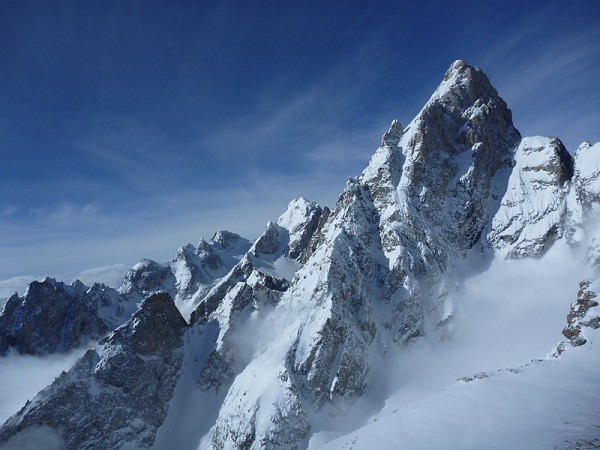
The north side of the Grand Teton.
Dawn came. Far above, the tip of the Grand began to glow in the morning sun. The first flush of light suffused the mountains, replacing the brooding hesitation of night with hope.
But as much as I tried, I couldn’t catch up. Mark talked over his shoulder as he broke trail up Burnt Wagon Gulch. I understood every third or fourth word. Not that it mattered. I was going as fast as I could, and I still couldn’t catch him.
At the top of the gulch, where Delta Lake spilled over the lip of the canyon toward the Valley floor, I demanded a break.
“Mark, you’re kicking my butt. You sure you haven’t been closet training?”
“You know, I think I just do better at altitude,” he said, shrugging his thin shoulders into a black down jacket. He pulled a peanut butter and jelly sandwich out of his pack and squeezed the top of it from a ziplock bag. “I’m terrible below 9 or 10,000 feet,” he mumbled between bites. “I don’t know what it is.”
I knew what it was. He was a mutant. He had run the Grand Traverse in eight and a half hours in summer, made its first ascent in winter, skied the first descent of the Black Ice Couloir and a new route on the 8027-meter Shishapangma. Most people who sit on the couch for eight months would still be in the forest. But I did wonder how deep his core strength really went.
We continued up the Teton Glacier moraine toward the south side of Teewinot. As we climbed, the clouds dropped away below. The valley was enveloped in them, but the north faces of Disappointment and the Grand sparkled with a clarity that seemed to highlight every feature.
Mark talked as he broke. Every once in a while, for propriety’s sake, I’d blurt out, “I’ll go.”
“Maybe in a minute,”he’d say. Then he’d just keep skinning.
Slowly we rose. When the north face of the Grand came fully into view, we stopped to admire its magnificence.
A thin ribbon of snow along the east-face skyline dropped from a notch directly to a white belt on the Grand’s north face, eight hundred feet below. This belt traversed to another couloir, which plunged again, steep as an elevator shaft, for 2,500 feet directly to the Teton Glacier. The Hossack-McGowan Couloir. Mark and Hans Johnstone had made its first winter ascent in February 1996, followed immediately thereafter by its first ski descent. Fifteen years later, it remained, arguably, the single greatest ski mountaineering accomplishment the Tetons have ever known. Looking at it made me feel nauseous.
We continued. Skin. Look up. Don’t look up. Keep going. The couloir snaked its way into my favorite part of the Tetons: a part I’d not yet visited.
Mark broke trail. The couple of times I’d managed to get out front, he’d called me aside minutes later. He’s so full of shit, I thought to myself. My breathing was haggard. He hasn’t climbed since July? I can’t even keep up.
One breath, one step. Another breath, another step.
Maybe I’m getting too old for this stuff.
Mark kept going.
The couloir braided into two branches. One branch ascended into a sinewy, shadowed couloir; the other forked left, into the sun. Everything now was awash in light, the north face of the Grand gorgeous in its cradling clouds.
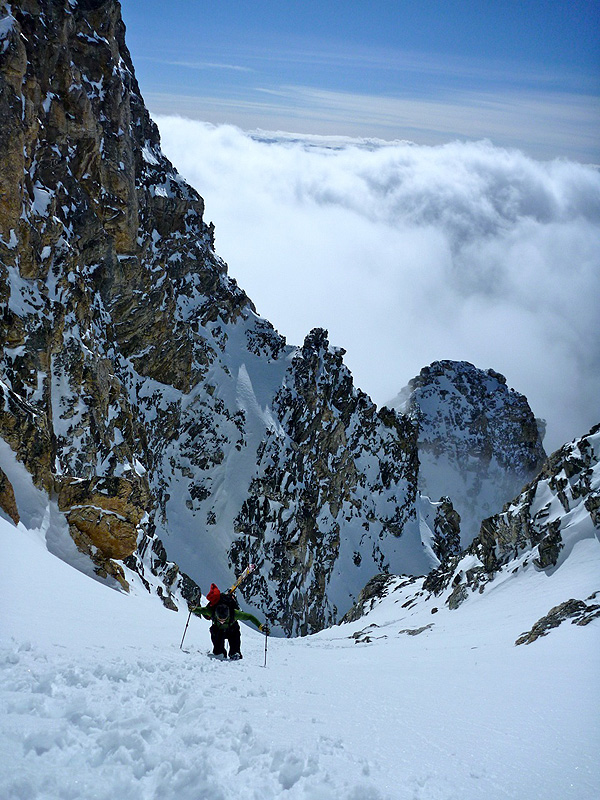
We switched to booting, and for one brief moment I moved ahead. Looking down at Mark, I felt as if I were in the Alps. I could swivel my head to take it all in: pointy Mt. Owen, the least accessible of the Cathedral Group; the north face of the Grand, etched against the sky; the Glacier Route on the Middle, as smooth and steep as the west face of Les Courtes; the jagged profile of the South, Ice Cream Cone, Gilkey’s Tower, Spaulding, Cloudveil, and finally Nez Perce, howling at the sky. The beauty of the mountains mesmerized me.
The effort, however, remained excruciating.
“What time is it?” I asked Mark when he reached me.
He pulled his shirt back from his wrist. “10,” he said.
No wonder it hurt so much. We were flying.
And still Mark climbed, and climbed, and climbed.
At last we broke out of the top of the couloir. I recognized familiar terrain: I’d last been here in August, on the Cathedral Traverse. But this time we weren’t headed left, toward Owen. Our route still lay above.
Twenty minutes later, we reached a notch. Mark had already climbed into it and was peering down, but I knew what was down there. Hard. Scary. Everything falling away. We would have to downclimb into it before we began to ski.
Beyond Mark lay another notch. This one was in the sun.
“Nuke. I need a break.”
“Why don’t we just keep going, over to the couloir?”
I looked into the abyss. Our couloir disappeared into a backdrop of rock and snow. I needed tea and real food and a moment to catch my breath. I needed to eat less, train more. I needed to lose weight. I needed to be nicer to my wonderful wife. I needed to be home with my beautiful daughter. I needed to be younger. I needed to think about whether I really should be doing this anymore.
“No. I need a break. Really.”
Mark relented. We downclimbed snowy ledges to the sun and shrugged into our layers. I pulled out a thermos of tea, then turned my pack over and sat on it. As I did, my heartrate subsided. I gazed at the north face of the Grand, and the serpentine line that Mark and Hans had skied. A moment later, I had to look away. It was too stunning.
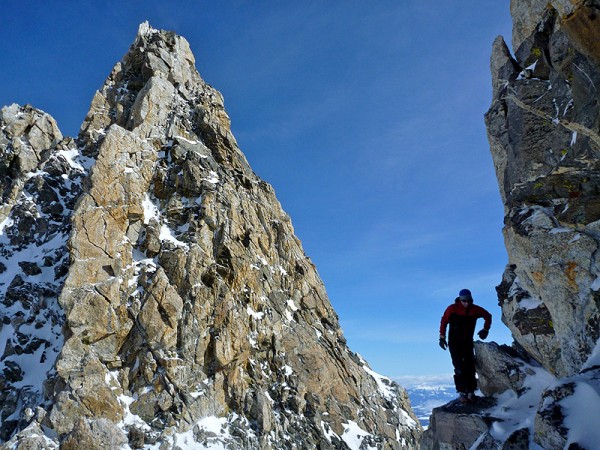
Refreshed, at least momentarily, we clicked into our skis, and Mark shuffled toward the start of the couloir. A traverse through a rock-pocked slope brought him into it. I joined.
Then I dropped, letting the steepness pull me down. It was immediately apparent that while most of the aspects in the Tetons featured suncrusted, windhammered chunk, way up here at 12,300 plus, our west-facing couloir was holding perfect, blower pow. The realization traveled through my skis, up my legs, into my chest and out my mouth. Whoop. It was the deepest, steepest powder I’d ever skied.
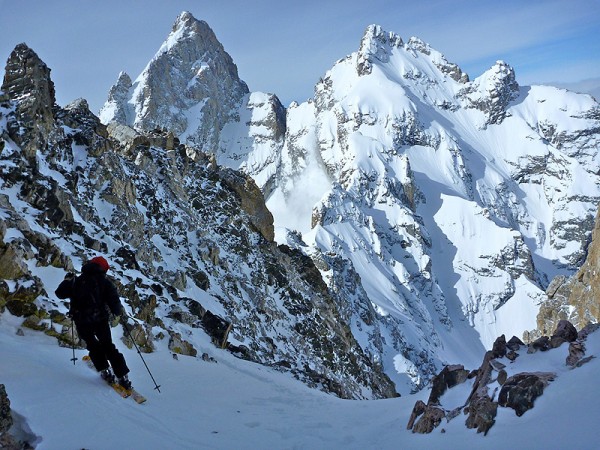
A hundred feet down, I stopped above a black, protruding fin, then yelled back. He whooshed past, clouds of snow billowing in his wake.
The couloir necked down, tighter, narrower, and as he turned he grew smaller until he simply disappeared.
“Clear!”
I dropped. It’s rare to ski in a position so high and exposed sensations that are ordinarily delineated merge into a continuum. Usually, the focus of making the next turn and the awareness of one’s surroundings remain compartmentalized. But now, as I turned, an opening began in my consciousness. Inside lay a vortex. The more I turned, the deeper I went.
With every turn I was aware of the perfection of the powder, the steepness of the angle, the depth of the couloir below, the height of the golden rock walls on either side, and the pull of a gravity so immense it seemed to draw from the mountain behind me, course through me, then fall away to the slope beneath my skis. Sensations inverted. The leapfrog to Nuke took perhaps a minute, but that minute morphed into something that was time, and also the understanding of my position, and also an appreciation of the couloir’s outrageous beauty, and also an awareness of the north face of Mt. Owen looming above. It was time, but it longer, deeper, thicker, broader. It was a pulse, and it emanated from the mountains exploding all around me.
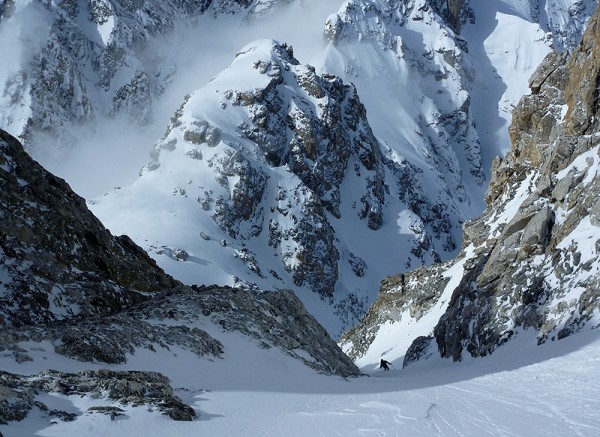
Gasping in disbelief, I reached Mark. He was grinning wildly.
“Go go go!” I yelled, and he dropped without hesitation.
Why talk? Why stop? Any fall would be fatal, and the only way out was down. Instead, we leapfrogged, one after the other, equally in thrall to the sensation, the topography, the fall line. Nothing else mattered. We’d moved into the place where mountain clichés reside. This was ridiculous, and we both knew it.
As I turned, some far-off part of me was astounded at the depth of my peripheral vision. I turned again, airborne. When I landed, the snow blew upward like down-pillow shrapnel. Outside my body the north face of the Grand and Owen’s northwest snowfields stretched up in a vast, halfmile arc. A memory arose with the next turn, of a moment twenty years earlier when a man who had picked me up hitchhiking dropped me off at the mouth of a valley in Alaska and I watched him drive for ten minutes before his car disappeared from sight. I began to understand the enormity of the space around me. I was nothing. The realization made me arrogant.
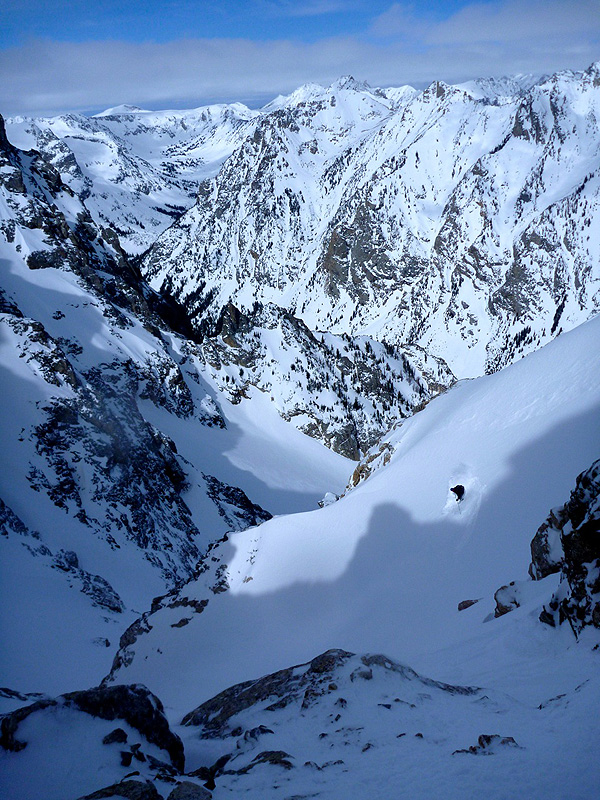
Again, the couloir necked down, so steep it vanished. I slowed my gorgeous, dreamlike turns. It was a chockstone.
I speedchecked again as I got closer. Could I get through? I peered over my pole for balance. The drop was steep—nearly vertical—and fifteen feet high. Maybe twenty. The angle kicked back below, but a fall would starfish me 3,000 feet to the basin floor. A moment later I was tips on rock, tails on stone.
What if I faced the other direction? The skittering dance began: I swung one ski out above the void so the tip faced the other direction. Groin out, exposed, I suddenly felt more vulnerable than I’d been in years. A bubble arose in my chest. I swiveled the other ski around to match.
Shit. This wasn’t going to work, either.
Slowly, carefully, I clicked out of one ski, then the other. I began a tenuous downclimb, probing below the steep slope with the ends of my skis. They quickly hit rock.
I didn’t want Mark to come down: his slough would knock me off.
“Hold on!” I yelled up. “I’m at a crux!”
“I think that’s where you need to downclimb!”Mark’s voice floated down to me.
Downclimb? We have to downclimb?
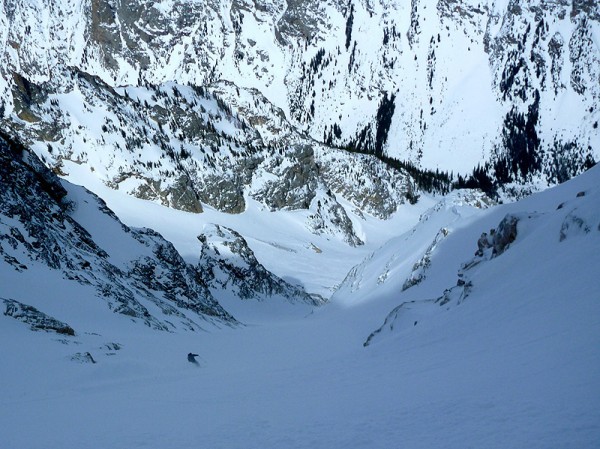
“Yes!” he yelled again. “That’s where I think I downclimbed!”
He hadn’t told me about any downclimbs. This was fucked. I was scared. I shouldn’t have been here. I was definitely too old for this shit.
I tried again. Using the skis as canes, I thrust them into the slot, more carefully this time. They went deeper than they had before, and I lowered myself, using them for support, then kicked another foothold. Another step, and the same thing happened. Twenty feet later I was in the pillowy deepness again.
The elation returned, more giddy this time. I clicked back in and started turning.
Oh my god the depths the softness the sensation of falling in a dream.
Finally I found a cliff to hide behind. “Clear!”I called up.
I yelled three times before snowballs began bouncing down the couloir, followed by his voice: “Skiing!”
He sprung into view, preceded by a wash of snow, then floated past me in a cloud. Dropping, dropping.
The couloir doglegged down from west to north. He arced out of view, and a few minutes later his voice came up to me.
Beyond that single syllable, there was no real need to communicate. We’d reached a symbiotic state: my turns began where his ended. I flew down. I soared. I skied without touching, as connected to air as I was to water. I expanded beyond any recognition of myself.
He was off on a shoulder to the right. I kept going.
Below, the couloir choked down again. As I got closer, I saw that it was filled with ice.
Mark skied up to me and examined the choke. “I don’t remember that at all,”he said.
“What time of year did you do this?” I asked.
“May.”
“May?”
“Yeah,” he deadpanned, scrutinizing the choke. Sometimes I think deadpan is the only demeanor he’s got. “I think this is where we need crampons and an axe.”
“What? We need crampons and an axe? I thought they were for the ascent!”
“Yeah,”he said, absently. “But maybe I can get through this.”
He inched closer while I processed our position. We were in a mountaineering situation. This wasn’t powder skiing. A far-off part of me experienced a longing to ski soft, effortless, inconsequential snow.
Mark pointed it. There was a poof of powder, and then he torqued the tails of his skis hard into a rightfacing turn.
Everything fell away. I couldn’t see what lay below. I felt lost in the vastness of the wall.
“I think this is where we need crampons and ice axe!”he called as he studied the terrain from his new position.
“Goddamnit, Nuke,” I cried. “We’re fathers!”
I inched closer to the ice, then hesitated. I would need to point it, stick the landing, then pull out hard to the right.
Most important: stick the landing.
“Five second rule,” I heard him say.
I pointed it. The ice flashed below me. An instant later, the tops of my toenails pressed into the tops of my boots as I pulled my tails around.
Below lay another drop. The closer I got, the more it opened up, so I just kept dropping.
Again the couloir doglegged, then suddenly it broke free of the walls, and I carved around a final corner to see the south wall of Mt. St. John bookending our descent.
We were in there. We were through it. We were home-free.
My speed increased as the couloir widened, but then my edges began to chatter. Exposed now, the slope had transformed from billowy to wind-hammered. My edges stuttered.
I pulled to a stop, thighs burning. Nuke ripped past, turning his way down the basin, then slowed as he approached a line of black and gray rock far below. He stopped on a ridge. I followed, pulling up as I got closer.
“I think this is where we need crampons and axe,”he shouted. “We’ve got to downclimb.”
Then he skied off again, ripping across the boilerplate.
Below us lay… what? I couldn’t tell. Beyond the rocks there was simply the nothingness that indicates a cliff. Beyond that, far below, the slope continued.
He gained a spine on the right and tried to peer over.
“It doesn’t go,” he yelled to me. “I think we need to climb over that ridge.”He indicated a rock rib to my left with his pole.
“Maybe we should have brought a rope,” he yelled.
I skied down to a flat spot at the head of a spine. Finally, something horizontal. Below the cliff remained a godawful amount of skiing. This place is like Tibet, I thought: a vastness that inhabits the mind.
While he was off on his spine to the east, I slowly, methodically broke down my next moves. I’m neither a good climber nor a good skier, but as I’ve grown older, I’ve become more methodical. It’s how I’ve stayed alive.
I was hot. Climbing would heat me up more, so: jacket off. I was dry. Water bottle out, thermos hood off: drink. Energy level? A little jittery. Two packs of Gu, down the hatch. Crampons on, careful that they’re seated. Axe out, loop around the wrist. Whippet out: click, into the top of the pole.
Ten minutes later, I was as ready as I was going to be.
Mark was still over on his spine, yelling something about going east to see if went.
“I’ll try over here!” I yelled, pointing toward the western ridge with my pole.
Mountain terrain in the winter is different than mountain terrain in the summer. In the summer, a rock rib like the one I climbed onto now would be little more than an afterthought. Here, though, iced up, fifty degrees, maybe sixty, was another matter. The granite was laced in ribbons of snow. One hundred feet below lay a windhammered, thirty-degree slope.
Maybe it was two hundred feet below.
Maybe I really was too old for this shit.
A frozen moss clump protruded from a corner. I swung my pick into it; the pick bounced back. Balanced precariously on the edges of my crampons, careful to keep the tails of my skis from hitting the rock, I palmed the granite with one gloved hand and kicked delicately for purchase. Rock? Ice? Moss? Whatever it was, it wasn’t what I wanted.
A rattling began, deep beside my lungs.
Hand on granite, I shifted my weight onto my outside foot, then sidestepped the other leg through to the next patch of snow. I transferred again, moving slowly, careful not to let my emotions jerk my moves.
A good stance. A sigh of relief. I could almost see over the ridge.
Then I spotted the rappel anchor.
The night before, Mark had texted me that maybe we should bring crampons and axe. I’d texted back that we maybe should also bring a helmet. And a rope. And a bolt gun. I wish we had all of them now.
I can’t believe there’s a rap anchor here! The voice in my head became shrill. I did not want to reverse those moves. Ahead lay more steep, snowed-up slab. Beyond that lay, as far as I could tell, another drop.
I could hear Nuke behind me, starting across the rock moves I’d just made.
“There’s a rap,” I said.
“What?”
“There’s a rap. Someone left a rap anchor.”
There it lay, frozen in the crack: booty. Specifically, a sling, a bentgate, a locker, a .75 cam and a godforsaken HB with a finger-trigger pull.
I did what any self-respecting climber would do, even one convinced of the near-possibility of his own demise. I retrieved the gear, then stuffed it into the front of my jacket, faced in, and kept traversing.
At the edge, I leaned over to brush snow off the holds below with my ski pole.
I dropped the pole. It bounced once, then skittered to a stop on a ledge thirty feet below.
Given my new perspective, the edges didn’t look as bad.
“Well, we’re committed now,” I said.
“What happened?” he asked.
“You don’t want to know.”
I kicked the snow off an edge, faced in, and found a handjam for my left glove. The resulting position felt both precarious and exposed.
“I hope this isn’t how I die,” I said, more for my benefit than for Mark’s.
I climbed back up, turned around, and faced out. Using the jam for my right hand, I lowered delicately to the next edge and kicked it free of snow. Feeling my way down, ten feet, twenty, I moved incrementally closer to the ledge.
A shift right, a last brushoff with a boot, and I lowered myself gently to the slope.
“You think you can lower the packs from there?” I called up.
He peered down at me. “You a good catch?”he asked. Then: “Wait—I’ve got some parachute cord in my pack.”
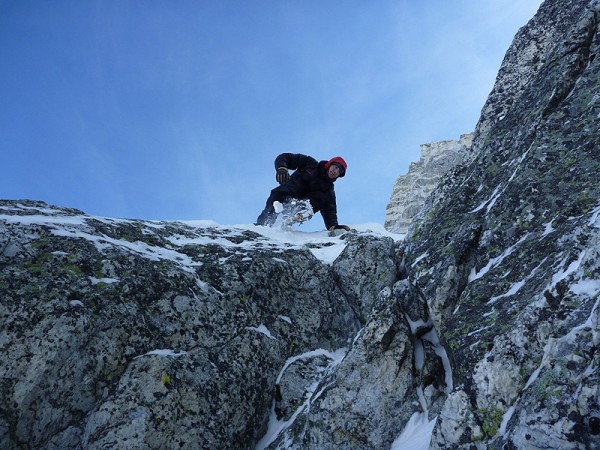
He fished around for a minute, then lowered my pack to me on thin black cord, skis and all, followed by his.
“I don’t know about this,”he said, peering over the edge.
“Don’t worry,” I replied. “It’s easier than it looks.”
He lowered himself tentatively to the first ledge, then the next. Soon, he was beside me. Below us, a snow traverse led to a ramp, which tongued down to connect to the slope.
When we reached it, the joy of an adventure between friends in our own back yard washed over us. We started laughing.
“You’re a dad!”I cried. “I can’t believe you brought us down here!”
“I don’t remember it being like this at all,”he said. He was laughing, too.
Ahead lay 1,500 feet of skiing to the bottom of Cascade Canyon. Beyond that remained hours of slogging to the car. It was 1:30; we probably wouldn’t make it. He’d be in the doghouse for a week.
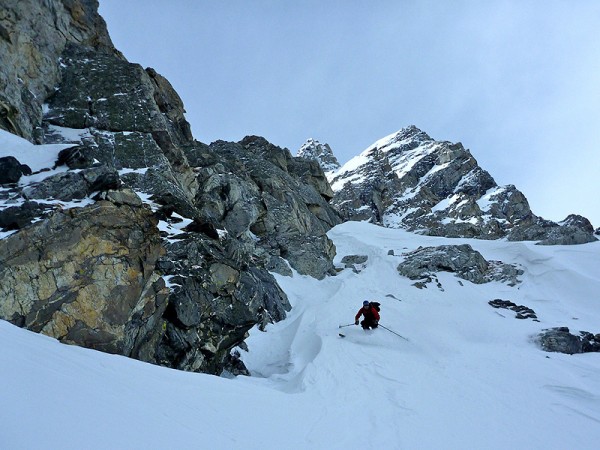
The next day, I’d learn that Mark’s May jaunt down the couloir years before, on skinny telemark skis and leather boots, had been the couloir’s first descent. As far as I’ve been able to find out, it had only been skied one time since.
As we stood there at the base of the cliff, though, none of that mattered. We couldn’t stop laughing. We were through. The next few hours might be hard, or grueling, or painful, and the fallout might suck for a week, but we were alive, the skiing had been stupendous, and the outcome had been uncertain the entire way, just the way we liked it.
I looked at Mark. He was giggling.
Nuke the Kook had come out of retirement. It was as if he’d never left.
